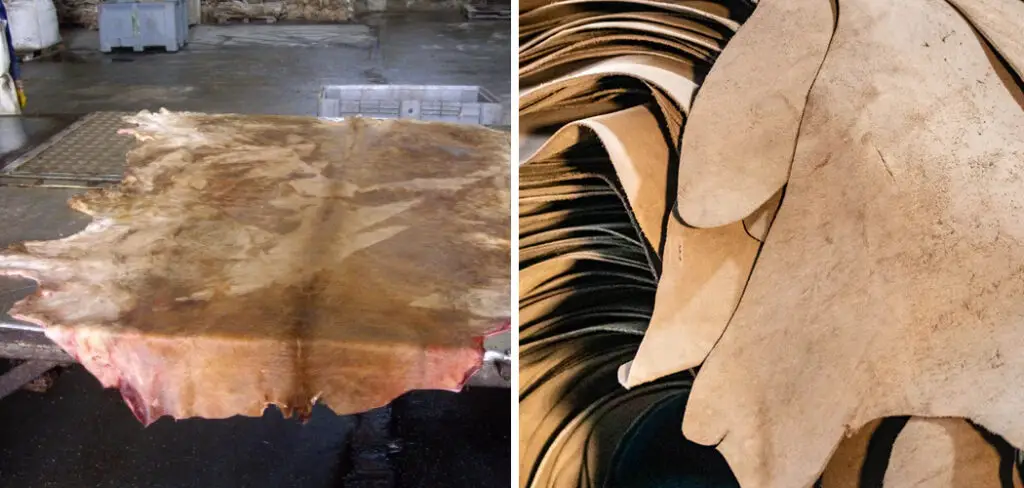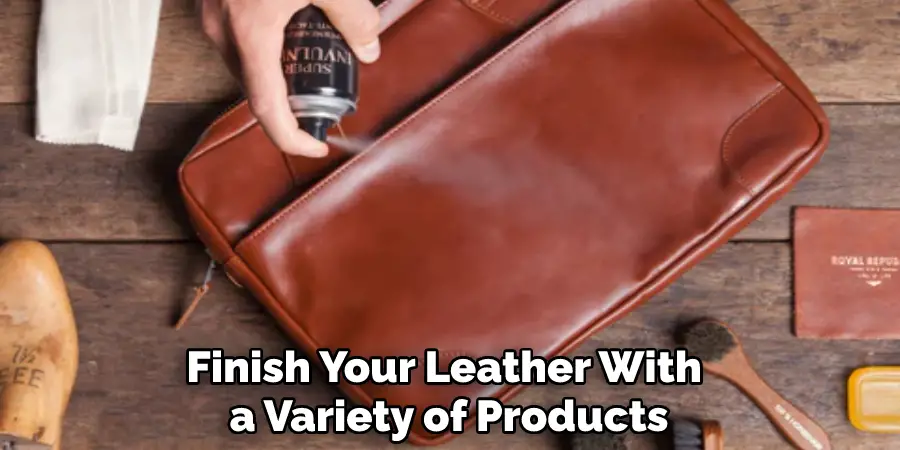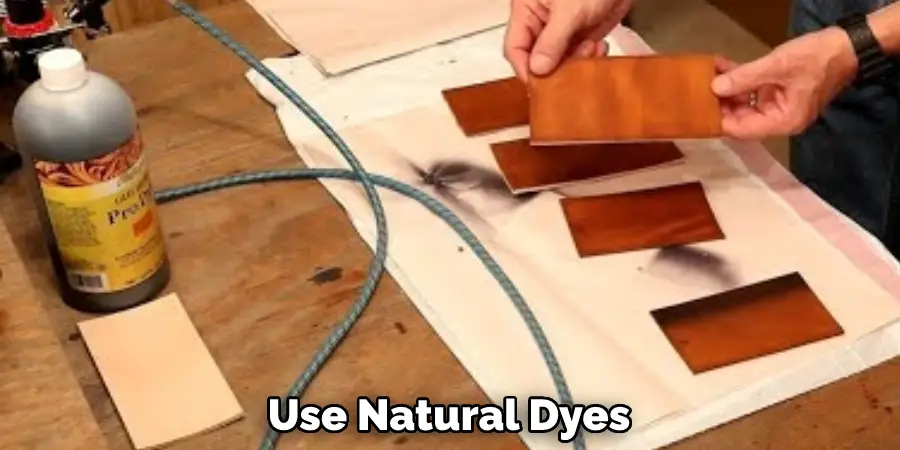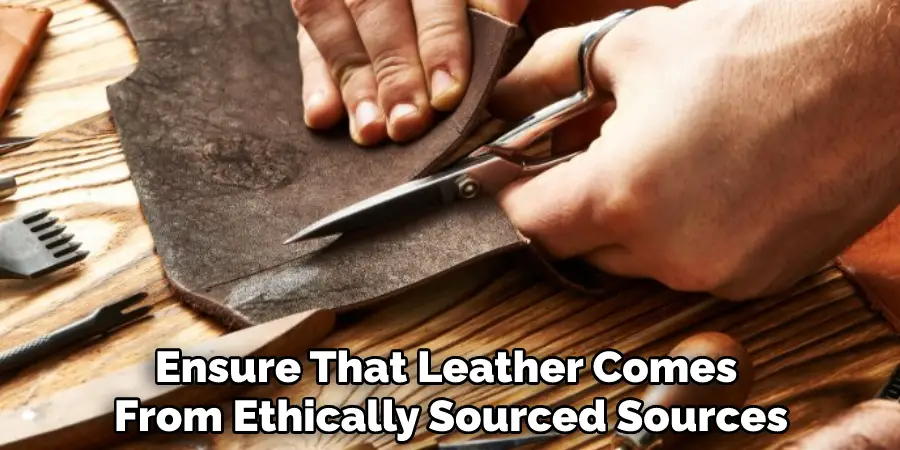Have you ever wondered how the stunning leather accessories and clothing you see in stores are made? It all starts with cows. Leather is one of the oldest materials used by humans, a testament to its durability and quality.

In this blog post, we’ll discuss the process of how is leather made from cows- from beginning to end. We’ll explore why cowhide is more popular than other types of animal skin, such as sheepskin or pigskin; what techniques are used during the tanning process; and different finishing touches that can be applied for an array of looks.
Understanding these processes will help you gain insight into why certain leather items may cost more than others due to their craftsmanship.
Step by Step Beginning to End Guidelines on How is Leather Made From Cows
Step 1: Harvesting
The first step in the leather-making process is harvesting the cowhide. Cowhides are typically harvested from cows that have been slaughtered for their meat, and it’s important to choose a hide that has not been damaged by any sort of illness or injury to ensure quality leather production. Harvesting is the most important part of the process as it directly affects the quality and look of the leather.
Step 2: Tanning
Once the hide is harvested, it must be tanned to prevent decay and prepare it for further processing. Tanning can be done with various chemicals, but most tanneries use mineral salts such as chromium sulfate, aluminum sulfate, and sodium chloride.

The hides are soaked in these salts for up to two weeks, which turns the hide into a durable leather material that is flexible, strong, and less prone to decomposition over time. Tanning will help the leather maintain its color and texture when it is used for clothing, furniture, or other items.
Step 3: Dyeing
Once tanning is complete, the hides can be dyed with various colors depending on what look the designer is going for. Dyes are typically vegetable- or metal-based, and this process affects how the leather looks and feels when complete. If you dyeing a hide creates an even coat of color or if the dye job is sloppy, it could impact the overall quality and look of the leather item.
Step 4: Finishing
The final step in how is leather made from cows is the finishing process. This process includes applying various oils, waxes, and dyes that will help protect the leather and give it a polished look. The finishing touches are what make the difference between an average-looking leather item and one that stands out from the crowd.
Now you know how leather is made from cows, start searching for quality cowhide items today! Quality leather can last for years if properly cared for, so it’s important to invest in quality items for the best bang for your buck. From handbags and wallets to jackets and shoes, you can find beautiful leather items that will last from season to season.
Additional Tips and Tricks to Make Leather From Cows
1. Make sure to use the hide from a cow that has been slaughtered humanely. This will ensure that you have an ethically sourced product and will help you produce the highest quality leather.
2. Always clean the hide thoroughly before beginning any tanning or other processing procedures. This will help remove dirt, oils, and other contaminants that can affect the leather’s quality.
3. Once the hide has been cleaned, it is time to begin the tanning process. This typically involves soaking and treating the hide with a variety of chemicals to help soften and preserve it. Different processes may be used depending on what type of leather you are trying to make.
4. After the tanning has been completed, the hide should be washed and then dried. This will help ensure that any remaining chemicals are removed from the hide and will also help it retain its shape.
5. Finally, you may want to dye or finish your leather with a variety of products available from leather supply stores. This will give your leather a unique look and also help it last longer.

By following the tips and tricks outlined above, you can make beautiful and long-lasting leather from cows. With a little bit of patience and practice, you will be able to produce fantastic pieces that will last for years to come.
Things You Should Consider to Make Leather From Cows
1. Quality of the Cowhide:
When making leather from cows, it is important to consider the quality of the hide that you are using. Cows with healthy hides will produce a better quality leather product than those with damaged or thin hides. If the quality of the cowhide is not up to par, it can negatively affect the quality of the leather made from it.
2. Processing Method:
The method used to turn cowhide into the leather will have an impact on the overall quality of the product. Different processing techniques such as tanning and dyeing can give different textures and finishes to the leather. Be sure to select a method that will best suit your needs.
3. Finishing Process:
The finishing process is another important aspect of making leather from cows. The type of finish used on the hide can affect the appearance and durability of the final product. Different finishes, such as waxing or oiling, will have a direct impact on the overall quality of the leather.
4. Care and Maintenance:
Once you have created your leather product, it is important to take proper care and maintenance of it in order to maintain its quality over time. Proper storage and cleaning methods will help ensure that your leather remains in good condition for years to come.

By considering all of these factors when making leather from cows, you can ensure that you are producing a high-quality product that will last for many years. With proper care and maintenance, your leather product will stay looking and feeling great for many years to come.
Precautions Need to Follow for Making Leather From Cows
1. Ensure that cattle are not overworked or stressed during the tanning process, as this will affect the quality of the leather produced.
2. Wear protective gear such as gloves and safety glasses when handling animal hides to protect yourself from bacteria and other contaminants.
3. Use chemical solutions in moderation to avoid damaging the hide fibers or creating toxic by-products.
4. Use natural dyes and preservatives to maintain the leather’s original color and texture.
5. Dry the hide in a temperature-controlled environment, as rapid drying can cause shrinking and other deformations.
6. Always store the leather away from extreme temperatures, humidity levels, and direct sunlight.
7. Carefully inspect the leather for any signs of damage before using it in your projects.

With these precautions in mind, you can be sure to produce beautiful, durable leather goods from cow hides. Investing in quality materials and taking the time to properly care for them will ensure that your leather products last a lifetime. Whether you’re making furniture, clothing, or accessories, properly cared-for cowhide leather will always be a timeless classic.
Frequently Asked Questions
Where Does Leather Come From?
Leather is made primarily from cows, although other animals such as goats and sheep can also be used. The hide of the animal is tanned to create a durable and strong material that can be used for clothing, furniture, and other products.
What Steps Are Involved in Making Leather?
The process of turning a cow’s hide into leather involves several steps. The first step is to remove the hair from the hide. This can be done mechanically or chemically, depending on the desired end product. After the hair has been removed, the hide is treated with salt in order to preserve it and prevent bacteria from growing.
Next, the hide is soaked in a tanning solution, which helps make it stronger and more durable. After that, the hide is dried and then colored with natural dyes or finishes such as waxes and oils. Finally, the leather is cut into pieces of various sizes and shapes according to its intended use.
What Are the Benefits of Leather?
Leather is a popular material for many products because it is strong, durable, and attractive. It is also resistant to water damage, making it ideal for furniture and clothing that may be exposed to moisture. Leather can also last for decades if properly cared for.
Additionally, leather has natural antimicrobial and antibacterial properties, making it a great choice for items that come into contact with the skin. In addition to these benefits, leather is also an environmentally friendly material since it is made from animal hides that would otherwise go to waste.
What Are Some Common Uses of Leather?
Leather can be used in a variety of ways, including clothing, shoes, furniture, automotive interiors and accessories, handbags, wallets, and other fashion items. It is also frequently used in bookbinding and to make musical instruments such as guitars. Leather has long been a popular material for making high-end luxury goods due to its strength and versatility. Furthermore, it is often used as an upholstery material for chairs, sofas, and other furniture.
Is Leather Sustainable?
Leather is a sustainable material because it is made from animal hides that would otherwise go to waste. Furthermore, the leather industry takes measures to reduce its environmental impact by using responsibly sourced materials and following strict regulations. Additionally, some companies are creating innovative technologies to help reduce the amount of water and energy used during the leather-making process. As a result, leather can be a sustainable choice for many items.
Is Leather Cruel?
Leather production does not involve any direct harm to animals as it is made from hides that are already dead. However, some people argue that raising animals for their hides can be cruel and unethical.
To ensure that leather comes from ethically sourced sources, look for labels such as “certified vegan” or “ethical leather” when shopping for products made with leather. Additionally, many companies are now embracing more sustainable practices and using alternative materials to create faux leather items.

Conclusion
To sum up the process, leather tanning starts with curing the hide and finishes in an embossing machine. All of the steps between these two are crucial for creating the highest quality leather that will last for years and look great. With careful attention to detail and a little patience, virtually any cowhide can be turned into luxurious leather products.
Knowing how is leather made from cows helps us to appreciate and value it even more. Not only do we recognize its beauty, but now we also know the effort put into its creation. Being conscious of such labor helps us further develop respect for such valuable resources.
Leather never ceases to amaze us with its ability to create a timeless fashion statement – recognizing how it begins as a humble abdominal skin on a cow adds even more appreciation for this incredible material!

